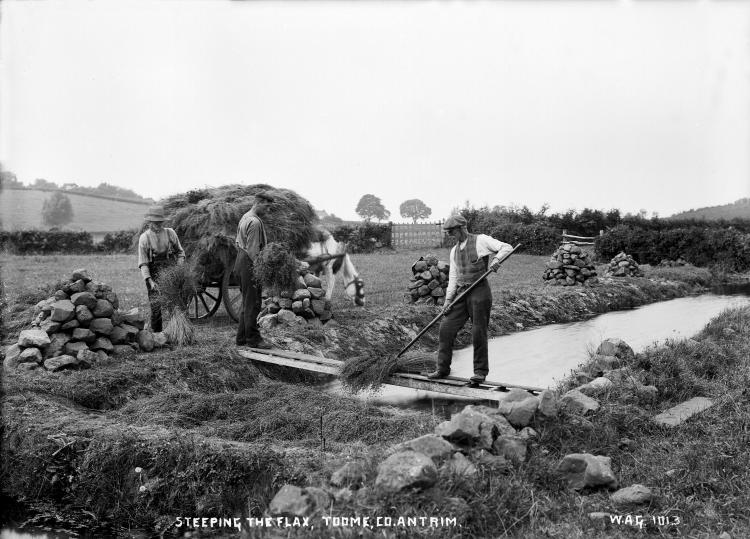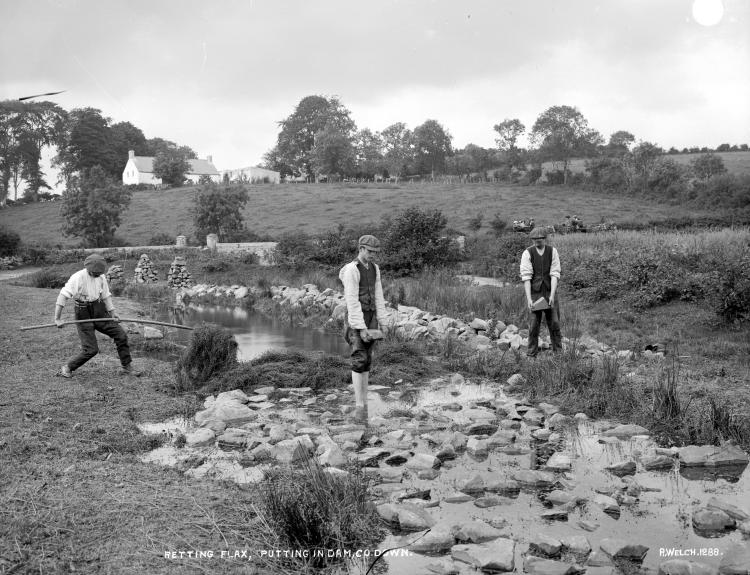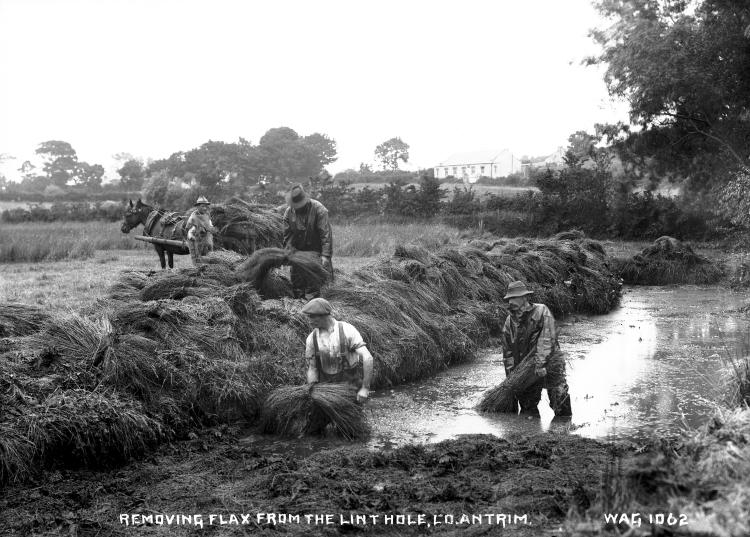
The Cottage Linen Weavers
Discover the fascinating history of Ireland's flax farming and linen weaving ancestors.
The Linen Industry in Ireland
People often assume that the linen industry was introduced to Ireland by the English in the 1700s. However, there is a long history of flax being grown, spun and woven into materials in Ireland since 1450. You wouldn’t think now that the textile industry was important to Ireland, but back then a lot of wealth was created through it.
After the 1700s, the exportation of Irish woollens was banned, which was a huge blow to the economy of Ireland. Wool, unlike flax, didn’t need to be imported to Ireland – the sheep were already there. Flax was different in that the seed had to be imported.
After the rebellions of 1688 to 1691, King William of Orange stated that he would do everything to discourage manufacturers in Ireland and encourage land manufacturer and trade in England:
“I shall do all that in me lies to discourage the woollen manufacture in Ireland, and to encourage the linen manufacture there, and to promote the trade of England.”
King Charles the Second enforced a lot of laws that stopped the Irish competing with the English as they wanted to keep as much money in their country as they could. England stopped the woollen and fine linen trade being established in Ireland so it wouldn’t compete against them.
Growing Flax
The linen industry initially operated out of the linen triangle – Lisburn, Ballymena and Belfast. Eventually, the spinning of the thread expanded out to the whole of Ulster, north Connacht and north Leinster.
In Ireland, a small area of ground could produce your flax, and keep a family going reasonably well, but there would have been a lot of competition for this land.
PULLING FLAX
Flax is a rotation crop which means that you couldn't grow flax in the same field year after year. You grew it you once every 5–10 years. Seeds had to be imported from America, Holland or Russia, and that made it quite expensive.
Flax is a fine crop and the finer the crop, the finer the linen, which is why it was pulled by hand. If you wanted to cut the flax, it would leave a couple of inches of fibre in the ground. Farmers didn’t want to do this because it would waste precious flax fibre.

Pulling flax was considered a great skill, and harvesting the crop depended on the type of flax farmers wanted to sell. The flax was pulled 100 days after it was sown, or three to four weeks after the first flowers appeared. Fine linen was pulled earlier, but if it was pulled too soon, the fibres would be too soft and couldn’t be made into linen.
If the flax was twisted or flattened by the rain, it was pulled as soon as possible because once it's flattened by the rain, the flax can be damaged. If it was too sunny, the plant went brown, and the fibres became brittle and discoloured. If this happened, the plant was pulled as soon as possible.
THE DAM
After harvesting, the flax was put into a dam so that the outside of the flax plant rotted. This allowed the farmers to harvest the flax fibres more easily. This was a job that had to be done very carefully so as not to damage the flax.
The flax was layered into the dam and weighed down with stones. If the stones were too heavy, the flax would be damaged. If the stones were too light, the flax would be able to rise up out of the water. This was considered an unpleasant job as the famers would be working with rotten material. The water couldn’t be let out into the river too quickly as it was poisonous to fish.
The flax remained in the dam between 7–14 days. It was a skill to know when to take it out. This was all dependant on the type of flax, the water temperature and the quality of the water. The flax was lifted out and set on the side of the dam to get rid of excess water before returning to the grass field, or a fire, to dry out. The drying process would take about 6 days, although this was dependent on the weather conditions. In some houses, the space in the rafters would be used for drying.
SCOTCHING & HACKLING
After the flax was dry, it was broken over the stone to loosen the outside of the flax. The flax was then scotched to separate the fibres – a process that involves breaking the flax straw and removing the woody parts. The flax was then hackled – a process which consists of flax fibres being straightened and sorted into coarse, medium and fine strands.

Hackling was a very skilled job and was where you made your money. A skilled hackler could get the majority of the very fine fibres out on their own and separate them out from the coarse. In the 1800’s, most of the flax in Ulster was being scotched in Scotch mills. It was quite a slow process but was a lot faster than hand scotching.
Flax would then be boiled in a pot to clean it and then spun on a flax wheel for measuring. One of the reasons Ulster did so well in the linen industry was their high-quality control in the drapers. The Linen Board would guarantee the quality of Irish linen because there were a lot of linen inspectors working with magnifying glasses to count the number of threads to the inch.
Industrialisation
Before the invention of the loom, the only way to create designs on the cloth was to have an additional operator on top of the loom, pulling pedals to create patterns that were required. Even when the loom was industrialised, this skill continued to be utilised in hand looms for a long time.
The cloth went through a chemical process to turn brown cloth into a high quality white bleached linen cloth. Usually this was done in factories where it was washed with sulfuric acid. The ordinary weaver would not have engaged in processes after the ground linen. Usually, it was sold to the draper or bleacher, and they took it on through the industrial processes.
As time went on, chemical processes became more advanced and evolved, but they still would have relied on grass at the end, as the linen was placed to dry under the sun.
Emigration
One of the things that stimulated emigration from Ulster was downturns in the linen trade, coupled with downturns in agriculture.
The weavers got used to a certain standard level and when the trade went down, they emigrated to America. The cottage linen weavers created wealth for themselves – even a poor family could afford a spinning wheel, but spinning was the first thing to become industrialised. The linen thread is being spun in the factories, so the spinners are made redundant.
By the 1820s, industrial spun yarn became available, but it was poor quality. The quality improved and by the 1830s, it wasn’t worth competing against.
The Irish Parliament dissolved in 1800 and any duties that are there to help local Irish industries were gone. The Irish were competing with the British economy - the most advanced economy in the world. This is the descent we see towards the famine. After the famine you had less people on the farm, and less people working on the land. It wasn't worth their while growing flax anymore.





